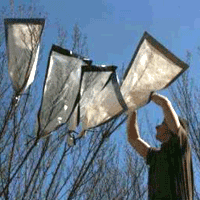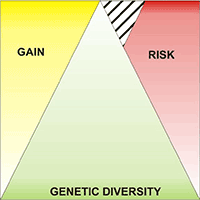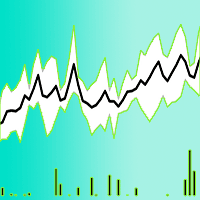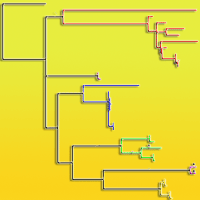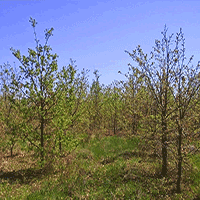
Testing Hungarian oak (Quercus frainetto Ten.) provenances in Romania
Ecaterina Nicoleta Apostol, Elena Stuparu, Virgil Scarlatescu, Marius Budeanu
iForest - Biogeosciences and Forestry, Volume 13, Issue 1, Pages 9-15 (2020)
doi: https://doi.org/10.3832/ifor3108-012
Published: Jan 08, 2020 - Copyright © 2020 SISEF
Research Articles
Abstract
In this study ten Hungarian oak provenances from Southern Romania were tested in two comparative trials 10 years after planting. The diameter at breast height (dbh) and tree height (Th) were measured in family progenies and the survival rate was determined. In both trials, the local provenances (Bals and Seaca 2) revealed superior fitness in terms of growth and adaptability traits, confirming the recommendation of using local provenances with priority in afforestation activities. Based on the measured traits, families which ranked in the first ten positions at age 3 and age 10 years were identified in both trials. The analysis of variance revealed statistically significant differences in growth traits between provenances and families in both comparative trials. Duncan’s test for 5% transgression probability revealed different results for dbh and Th in terms of provenance homogeneity in the two test sites, with a superior homogeneity in the Aramadia trial for dbh and in the Bals trial for Th. Growth performances of the Hungarian oak provenances were significantly influenced by the experimental location and by the interactions between provenance, family and locality, suggesting that maximum precaution must be taken in the choice of forest reproductive materials to be planted in different environmental conditions. The family mean heritability (h2f) was significantly lower than the individual heritability (h2i), suggesting the possible adoption of an individual selection strategy in the next stage of the current breeding programme. The juvenile-adult correlations will be made at the age of 40 years and will take advantage of the results of this study to shorten the testing period for the selection of genetically improved material in Hungarian oak.
Keywords
Age-to-age Correlations, Breeding, Forest Steppe, Oaks’ Adaptability, Selection Strategy
Authors’ Info
Authors’ address
Elena Stuparu
Virgil Scarlatescu
Marius Budeanu 0000-0001-9849-0527
National Institute for Research and Development in Forestry “Marin Dracea”, Voluntari, 128 Eroilor Boulevard, 077190, Ilfov County (Romania)
Corresponding author
Paper Info
Citation
Apostol EN, Stuparu E, Scarlatescu V, Budeanu M (2020). Testing Hungarian oak (Quercus frainetto Ten.) provenances in Romania. iForest 13: 9-15. - doi: 10.3832/ifor3108-012
Academic Editor
Marco Borghetti
Paper history
Received: Mar 25, 2019
Accepted: Oct 23, 2019
First online: Jan 08, 2020
Publication Date: Feb 29, 2020
Publication Time: 2.57 months
Copyright Information
© SISEF - The Italian Society of Silviculture and Forest Ecology 2020
Open Access
This article is distributed under the terms of the Creative Commons Attribution-Non Commercial 4.0 International (https://creativecommons.org/licenses/by-nc/4.0/), which permits unrestricted use, distribution, and reproduction in any medium, provided you give appropriate credit to the original author(s) and the source, provide a link to the Creative Commons license, and indicate if changes were made.
Web Metrics
Breakdown by View Type
Article Usage
Total Article Views: 44565
(from publication date up to now)
Breakdown by View Type
HTML Page Views: 38227
Abstract Page Views: 3053
PDF Downloads: 2462
Citation/Reference Downloads: 10
XML Downloads: 813
Web Metrics
Days since publication: 2185
Overall contacts: 44565
Avg. contacts per week: 142.77
Citation Metrics
Article Citations
Article citations are based on data periodically collected from the Clarivate Web of Science web site
(last update: Mar 2025)
Total number of cites (since 2020): 2
Average cites per year: 0.33
Publication Metrics
by Dimensions ©
Articles citing this article
List of the papers citing this article based on CrossRef Cited-by.
References
Cercetari ecofiziologice în cerete si grnitete afectate de fenomene de uscare [Ecophysiological research in the Turkey oak and Hungarian oak stands affected by drying phenomena]. PhD thesis, Forest Science Department, Transylvania University of Brasov, Brasov, Romania, pp. 43. [in Romanian]
Gscholar
Changes in genetic control of growth of radiata pine to 16 years and efficiencies of early selection. Silvae Genetica 37: 138-146.
Gscholar
Introduction to quantitative genetics (4th edn). Longman and Co., Harlow, NY, USA, pp. 360.
Gscholar
Red list of fern and vascular plants. In: “Red list of plants and animals of Slovakia Nature conservation” (Marhold K, Baláž D, Urban P eds). Štátna Ochrana Prírody Publisher, Bystrica, Slovakia, pp. 44-76.
Gscholar
Red list of the vascular flora of Hungary. Private edition, Sopron, Hungary, pp. 73.
Gscholar
Quercus frainetto in Europe: distribution, habitat, usage and threats. In: “European Atlas of Forest Tree Species” (San-Miguel-Ayanz J, De Rigo D, Caudullo G, Houston Durrant T, Mauri A eds). Publication Office of the European Union, Luxembourg, pp. 2, e01de78.
Online | Gscholar
Are sprouts the dominant form of regeneration in a lowland Quercus pubescens-Quercus frainetto remnant forest in Northeastern Greece? A regeneration analysis in the context of grazing. New Forests 45: 165-177.
CrossRef | Gscholar
Catalogul national al resurselor genetice forestiere [National catalogue of forest genetic resources]. Silvica Publishing House, Bucharest, Romania, pp. 525. [in Romanian]
Gscholar
Catalogul national al materialelor de baza pentru producerea materialelor forestiere de reproducere [National catalogue of basic materials for the production of forest reproductive materials]. Silvica Publishing House, Bucharest, Romania, pp. 304. [in Romanian]
Gscholar
Chloroplast DNA variation in European white oaks. Phylogeography and patterns of diversity based on data from over 2600 populations. Forest Ecology and Management 156: 5-26.
CrossRef | Gscholar
Genetica si ameliorarea arborilor [Genetics and trees breeding]. “Pentru viata” Publishing House, Brasov, Romania, pp. 455. [in Romanian]
Gscholar
Dendrologie [Dendrology]. Transylvania University Publishing House, Brasov, Romania, pp. 418. [in Romanian]
Gscholar
Forest genetics. CABI Publishing, Cambridge, UK, pp. 682.
Gscholar





